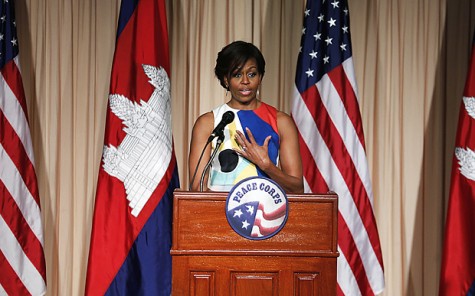Michelle Obama’s new initiative: Let Girls Learn
November 17, 2015
Sixty-two million girls around the world are not in school and are not receiving educational opportunities due to oppressive societies and cultural biases.
On Mar. 3, 2015, First Lady Michelle Obama announced her new initiative Let Girls Learn, with the support of President Barack Obama.
As of 2012, every developing region in the world had reached or was close to reaching gender equality in primary education. However, parity does not extend to secondary schooling and adolescent girls continue to be barred from school and, consequently, the work force.
In developing countries, research studies have shown that when a man is educated he can maintain himself, but when a woman is educated she can boost her entire family’s economic status. Girls who attend secondary school marry and have children later; additionally, they have lower maternal and infant-mortality rates and lower rates of HIV and AIDS. Every additional year of school can increase a girl’s earning power by 10 to 20 percent. However, while boys are attending school, girls are being left behind, marrying earlier, having children earlier, and working menial jobs.
“These girls walk miles each day to school, study for hours each night, and stand strong against those who say they are undeserving of an education. If they are prepared to make these sacrifices, the global community should be able to summon the resources to help them fulfill their promise and the promise of their families, communities and countries,” Michelle Obama wrote.
Let Girls Learn is a program in partnership with the Peace Corps and USAID that teaches developing countries the importance of educating girls and helps girls to go to school and stay in school. The United States currently has 7,000 Peace Corp volunteers working in 11 countries to devise solutions for the educational deficit among girls.
In Cambodia, only 54 percent of girls finish their last year of primary school. Without completion of primary school, these adolescent women are prohibited from gaining higher education.
In Ghana, 53 percent of girls believe domestic violence is justifiable. This social norm can be broken through education, empowerment, and support.
In Mongolia, 55 percent of girls work dangerous, subsistence, unpaid jobs. Greater achievements can be cultivated through education and cultural equality.
Fiker is a 13 year old girl living in Ethiopia. After learning her parents were secretly arranging her marriage to a man she’d never met, Fiker used the empowerment USAID had taught her to stand up for herself. She refused marriage and instead continued her education.
Before confronting the lack of schooling for girls, volunteers must first confront the reason girls are forced from their education. Issues that keep girls out of school include: female genital mutilation, early forced marriage, unaffordable school fees, the potential loss of girls in household labor, and unsafe routes to school that could result in rape.
Safety is a major aspect. Parents worry that their child will be raped on the way to school, not because of the emotional and physical harm it will cause, but because their daughter will then be considered damaged goods and consequently ruin their marriage prospects. “In working to educate girls, we are often asking people to disregard deeply held traditions and do what seems to be against their daughter’s best interest,” Obama wrote in a commentary for the Wall Street Journal.
Peace Corps volunteers are already working side-by-side families and community leaders in small projects. With the implement of Let Girls Learn, volunteers will transition into finding community based, lasting solutions for girls’ education. Peace Corps will improve education through three Pillars of achievement: Empowering leaders, Working hand in hand with communities, and Increasing the impact of Peace Corps volunteers.
For decades USAID has been working in developing countries worldwide. Let Girls Learn will build on this work, while USAID focuses on increasing access to education, empowering young girls, and reducing the barriers blocking girls’ success. USAID invests around $1 billion dollars annually in education programs and has trained over 300,000 teachers in developing countries.
“Given the magnitude of the challenge, U.S. action alone will not suffice, nor will the efforts of just a few concerned countries. That is why this week in Japan, we will call for countries around the world to join us by making their own investment to help girls learn,” Obama said during her visit to Japan and Cambodia in March of 2015. Throughout this five day trip, Obama met with Akie Abe, the wife of Japan’s prime minister, in Tokyo. Together, they announced their partnership in Let Girls Learn and traveled to schools in Cambodia, the first country this initiative will be implemented.
Michelle Obama is currently traveling to the Middle East. While in Jordan, she will visit schools that are educating children who have recently fled from Syria and highlight the power of continuing girl’s education. In Qatar, she will attend a global education conference. She explained, “I’ll be urging countries around the world to both make new investments in girls’ education and challenge laws and practices that silence, demean, and brutalize women.”
Let Girls Learn is reaching 62 million girls around the world and breaking the barriers that surround education of women. Developed countries are in partnership, and led by Michelle Obama, to invest in the education of girls and break the social norms that keep girls out of school. Even though this initiative is based in third world countries, it connects to students in the United States. She explained, “Through Let Girls Learn, I want girls-and boys-here in the U.S. to learn about the challenge girls worldwide face in getting an education. I want them to understand that even though their own school might be far from perfect…they still have the responsibility to show up everyday and learn as much as they can. And I want them to connect with other young people from every background and nationality, particularly woman who set such a powerful example.”











